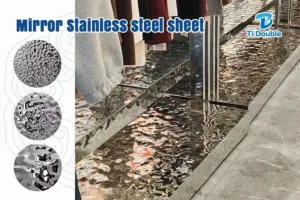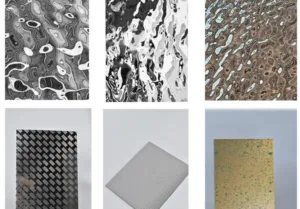Table of Contents
- What is Rigidized Stainless Steel?
- How is Rigidized Stainless Steel Made?
- 10 Advantages of Rigidized Stainless Steel
- Applications of Rigidized Stainless Steel
- Transportation and Aerospace
- Rigidized Stainless Steel vs. Standard Stainless Steel
- Environmental Benefits of Rigidized Stainless Steel
- Choosing the Right Rigidized Stainless Steel
- Installation and Maintenance Tips
- Where to Buy Rigidized Stainless Steel
In today’s modern design and engineering landscape, Rigidized Stainless Steel is quickly emerging as a preferred material. While traditional stainless steel already offers durability and corrosion resistance, the rigidized embossing process elevates its performance by adding permanent textures that improve both strength and aesthetics.


With growing demands for functionality, sustainability, and visual appeal, more architects, designers, and engineers are turning to Rigidized Stainless Steel for their projects.
This article will guide you through its definition, unique benefits, manufacturing process, real-world applications, and why it is increasingly seen as the material of the future.
What is Rigidized Stainless Steel?
Definition and Features
Rigidized Stainless Steel is stainless steel that has undergone a cold-rolled embossing process, creating permanent surface textures. Compared to traditional stainless steel, it offers:
* Scratch resistance – surface textures distribute pressure and minimize visible damage.
* Lightweight strength – thinner sheets achieve the same performance as thicker standard sheets.
* Aesthetic versatility – decorative finishes for modern architecture and interiors.
* Reduced glare – textured surfaces diffuse light, improving visibility and comfort.
How is Rigidized Stainless Steel Made?
Embossing and Cold-Rolling Technology
Sheets of stainless steel pass through patterned rollers, imprinting permanent textures into the surface.
Thickness and Strength
Texturing not only enhances visual appeal but also provides greater structural integrity without adding extra weight, making it cost-efficient and practical.
10 Advantages of Rigidized Stainless Steel
1. Superior durability – resists scratches, dents, and heavy wear.
2. Lightweight and material-efficient – maintains strength while reducing thickness.
3. Modern aesthetics – dozens of textures for design flexibility.
4. Slip resistance – ideal for flooring, elevators, and public spaces.
5. Lower maintenance costs – surfaces hide minor blemishes, staying attractive longer.
6. Fingerprint resistance & easy cleaning – keeps a clean, professional look.
7. Eco-friendly – fully recyclable, sustainable material.
8. Corrosion resistance – excellent for humid and outdoor environments.
9. Reduced glare – safer and more comfortable in high-traffic spaces.
10. Long-term investment value – slightly higher upfront cost, but much cheaper over its lifecycle.


Applications of Rigidized Stainless Steel
Architecture and Interior Design
* Building façades and curtain walls
* Elevator interiors and button panels
* Kitchen countertops and cabinetry finishes
* Hotel and retail wall cladding
Industrial and Manufacturing
* Machinery housings and protective covers
* Heavy-duty flooring and workstations
* Equipment surfaces in high-traffic facilities
Medical and Food Industry
* Operating room equipment
* Food preparation and processing tables
* Public health and sanitation facilities
Transportation and Aerospace
* Aircraft cabin walls and finishes
* Automotive trims and interior parts
* Ship and rail interiors
Rigidized Stainless Steel vs. Standard Stainless Steel
| Feature | Standard Stainless Steel | Rigidized Stainless Steel |
| Scratch Resistance | Scratches easily visible | Textured surface hides scratches |
| Weight Efficiency | Requires thicker sheets for strength | Thinner sheets achieve equal strength |
| Aesthetic Options | Limited surface finishes | Dozens of patterns and textures |
| Maintenance Costs | Higher cleaning and upkeep | Easier to maintain, cost-effective |
Environmental Benefits of Rigidized Stainless Steel
* 100% recyclable – contributing to circular economy.
* Lower material usage – stronger with less thickness, reducing resource consumption.
* Energy-efficient manufacturing – optimized production lowers environmental footprint.
* Green building compliance – widely used in LEED-certified projects.
Choosing the Right Rigidized Stainless Steel
* Popular patterns: linen, diamond, quilted, and leather-grain finishes.
* Thickness selection: thinner sheets for decorative use, thicker sheets for structural needs.
* Customization: bespoke textures available for unique design projects.
Installation and Maintenance Tips
Installation Guidelines
Ensure a flat and stable substrate.
Use proper fasteners to avoid surface damage.
Consider thermal expansion for outdoor installations.
Maintenance and Cleaning
* Clean with mild soap and water.
* Avoid strong acids or abrasive chemicals.
* Perform regular inspections and light polishing when needed.
Where to Buy Rigidized Stainless Steel
Finding a trusted supplier is crucial when choosing Rigidized Stainless Steel for your project.
* Rigidized® Metals Corporation remains one of the leading manufacturers specializing in high-quality textured stainless steel.
* For more options in stamped stainless steel sheet finishes, you can also explore the [Classic Series by Color Metals], which offers durable, decorative stainless steel sheet patterns suitable for architectural and industrial use.
When purchasing, always consider:
* Required thickness and grade
* Intended application (decorative vs. structural)
* Finish and texture style
* Budget and lifecycle cost





